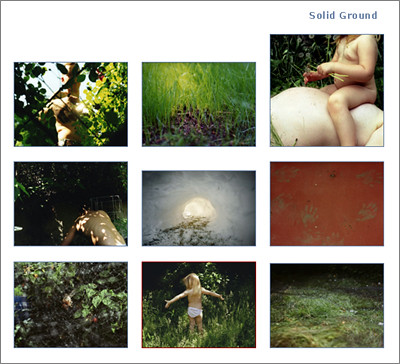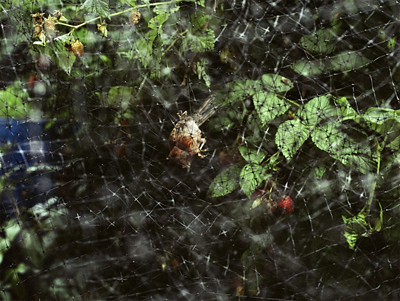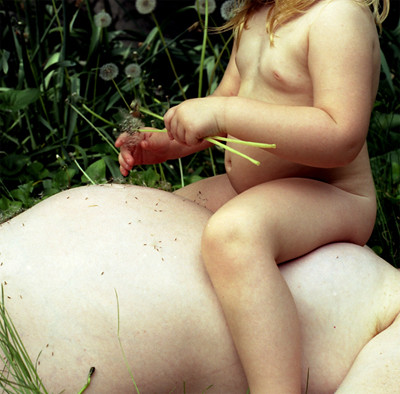
Last Thursday I spoke with photographer Holly Lynton at Jen Bekman Gallery about her recent body of work Solid Ground. The conversation is too long to post in its entirety, so I have taken the liberty of posting some of highlights of our conversation for those who missed the talk. Unfortunately, the show is no longer on view, though I suppose there is some consolation that you can view all the images of the works in the show at Jen Bekman’s site and installation photos at via flickr here. Jpegs, are of course, a pale substitute for the show, but what can I say — exhibition experiences that take place within the column width of a blog always are.
Paddy: …I'd like to begin by talking to you Holly, a bit about your process, because I think I think that this is something that will ground the discussion a little bit. So lets start with how the photographs are set up because some of the photographs looks staged, and others maybe a little less so. I would say an example of something that looks staged is the belly picture behind the desk, and I think yesterday when we talked I think you had said that the slugs were staged, although actually, I would not have deduced that on my own. I wondered if you could talk a little bit about how planned out these shots are and if this body of work is basically conceived before you shoot it?
Holly: Well”¦one of the things I was really pleased about with this body of work is that I was able to work in different ways. A couple series before, and actually the one right before [Solid Ground] were very set up. They are self portraits so they had to be, but this incorporates pictures that I guess are very staged in the sense that I chose the elements, (for example the slugs I captured them in my garden, and put them in habitats until I was ready to take a picture.) But then, even when my pictures are set up, they're slugs and I can't control them, and they actually move a lot faster than I anticipated so there are things that happen in the act of picture making that are always a surprise. So I guess [because the work] is also generated in different ways so when I made [the bellies] it wasn't that I had a specific picture in mind, I just wanted to honor my daughter when she was born”¦.she was really round”¦and she had this really round budda bella that I figured over time would disappear because my husband is very tall it would go away, and I was pregnant with my second child and I had this belly that was getting bigger. So I really wanted to make a picture about those two things. I didn't really have what it was going to be in mind, and I guess some how I decided to have her sit on me, and the dandelions were there so we started working with them, and I had her sit on my chest because I didn't want parts of me exposed”¦but I did necessarily anticipate, because she's sitting on my chest, that some people wouldn't be able to tell where the legs are or that kind of thing, so there's stuff that I just can't anticipate.
So some of them, like the snow and the paw prints, those are examples of I just came out and the photograph was there, so I took it. The snow tunnels were there, and it was beautiful, so I photographed it. So I guess there are three ways, there are things that come up in my imagination and then I set about making a photograph, there are pictures that I just happen upon, and then there are pictures that are recreations of events. The slugs are good example of the last way of working”¦.a friend and I were sitting about drinking Mojitos one summer night, and we were about 10, 12 feet apart. When we were drinking them and putting them on down on the rocks, and it was gross and amazing to me that these slugs, within only an hour had smelled the drinks, and ended up on our cups. So that happened in the summer, I think I had the idea to recreate the event in January or February, so it was the next summer when I made the picture. So that's why these things just seem to sit in my subconscious somewhere and I have the idea that I want to make the picture and it's usually the wrong season.
Paddy: How long did it take you to put this particular body of work together?
Holly: It was actually about a couple of years I think. I mean I made a few of them and then I wasn't really sure what I was doing with the body of work, and then I made the self portraits, the other series, and then came back to this. Now that it's completed it's hard to really know how it all happened. Some of it was kind of like a dream to me. I mean obviously there's thoughts and ideas and I'm working towards something but that part of it is sort of hard to articulate sometimes.

Paddy: Still on the subject of the process of this particular series; all the work here is taken outdoors so the light is natural. How important is natural light to you, do you ever take photographs indoors?
Holly: I try to take pictures indoors. Actually the prior series was indoors, but I brought the natural world indoors and photographed it in natural light and in my mind, it spoke to the idea of controlling nature. I mean in these, the light was really important and some of the early ones, and when I first started making the series I was sort of worried that they would have this really direct intense light source, and I was attached to that for a while. But there were pictures that happened that didn't fit that perimeter so I guess when we talk about my editing process, the paw prints that's flat light, so I kind of had to let go of the idea that all of these pictures were going to have this very specific light. At some point I think photographing in my back yard became more important to me than having this idea that the photographs are going to be about this kind of light, and if you're photographing in your back yard, obviously the light's going to change. But I still want them to be taken in the light it's just not always direct. I mean I want the light to beautiful in some way, to help to make the picture, but I can't always control what's happening. Like when I shot this picture (above), it rained for two weeks before I was able to make this picture. And I was flying to France the day I took this picture. And it rained in the morning, and there was this moment when I could take this picture, and then it was the only time I could take the picture because the raspberries had to be ripe, so there are a lot of things that go into it. It would probably be easier to use strobes and stuff. I just don't.
Paddy: One of the things I like about your work is that the full narrative isn't presented to the viewer which in a lot of ways mimics how we experience things in our day to day lives. Just as you might meet somebody but you aren't privi to their back story so what you have is this very limited engagement, so what you know is what we experience from that moment on. So what's really important is that you chose and construct specific moments for the viewer”¦and your work seems very specific to me. Should I assume editing is part of the reason for this? Let's say you have 150 pictures (I'm choosing this number at random), what is your selection process? How important is that the photograph remains uncropped, how does the role of beauty play into your work, and do set thematics effect the editing process?
Holly: Well, for me, it's sort of interesting, because I don't think I ever have a hundred and fifty pictures in front of me too choose. It's just not the way I make work. I generate a lot of ideas. I used to write them on scraps of paper which I decided was bad, so I got a little pretty notebook and I write them down in there. Because like I said, I have these ideas in January, and I can't make a picture until July, so I can forget the idea”¦.Some of them obviously are bad and they get chucked out. I think it's more like I kind of keep shooting and as I make photographs they go on the side I keep or the side I don't and once it's done, it's just done. So, I guess my selection process is done more as I go along, as opposed to photographing a bunch of things and then looking at what I photographed and selecting from there.

On the subject of cropping”¦I don't generally crop because where I went to school they didn't let you, so I just got used to that. I mean, except for if it is intentional (the bellies for example [above].)
As for beauty”¦it is always a factor in my work. I mean I want my photographs to be beautiful, and I want them to be vibrant and larger than life. I guess for me, because they are coming from my imagination, and these dreams, I feel like they should be this kind of color. And I go out in the world every day, and I don't always see that. I mean I go out into my garden and it's fall now so it's kind of dingy, and I see the weeds and the tomato that should be ripening but is really rotting instead. But [my photographs] are the way I wish the world would be in terms of color”¦.and they should express beauty in some sense, but I don't want them to be just about beauty. I think there's other stuff that's under the surface.”¦you know for example, yesterday I came out of Columbus circle and there was this dead bird on the ground, and”¦ I had to check to see if it was a fake bird because it was this yellow breasted bird it didn't look like a city bird. Nobody seemed to be noticing it”¦you know, everyone was just sort of walking around it, and I kept thinking someone was going to step on this thing — I mean it was just sort of amazing to me that nobody stopped to look at it and for me, partially, whether the moments are beautiful or not, it's those things that you notice, that I notice, that I don't know if everybody else notices”¦I'm still obsessed with not having my camera yesterday.
You know my trip to Africa was really important in this respect”¦.I went to Africa in 2001, so a lot of these pictures were made later. But when I went there it was right after September 11th”¦ we were supposed to leave on September 12th, so we left a week later, and we went on a safari. So I went from watching the world trade center fall down to being in the trees in the bush a week later and it really freaked me out. I mean it was beautiful, but the camp manager was showing me pictures of green mamba snakes on the path, (I don't know if anybody knows about green mamba snakes but they bite you and you die) so, for the first three nights I didn't sleep because I was sure that I was going to get up in the middle of the night and there was going to be a snake in my bed”¦but then I sort of got acclimated and it was great”¦but it was this interesting experience coming to this place with all this fear and being in this incredibly gorgeous place that's so larger than life, but feeling like you could really die at any moment, to ended up feeling like it was okay if you died at any moment because that's just the way it is there.
So coming back here, and it was around the time of West Nile, and we were spraying like mad,”¦to me it's like that psychology of fearing the natural world and trying to control it as opposed to embracing it and loving that you could die in it. So coming from that experience, I'm not saying that you would look at these pictures and say they have anything to do with Africa, but I think that just encouraged me to look at things that were happening in my backyard, or look at them in a way that I wouldn't necessarily otherwise. So for me that's my personal relationship for why I started making the work. You know, would I say that that's what the work is about, no not necessarily, but I always like my work to be about what other people get out of it as much as my own personal experience.


Comments on this entry are closed.